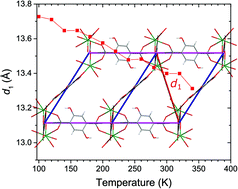Guest-dependent negative thermal expansion in a lanthanide-based metal–organic framework†
Abstract
A lanthanide-based metal–organic framework (MOF) named SION-2 displays strong and tuneable uniaxial negative thermal expansion (NTE). The coefficient of thermal expansion α1 reaches −153(6) MK−1 between 100 and 340 K, which is the highest value reported to date for Ln-based MOFs. After heating to 380 K and subsequent cooling, the directionality and the magnitude of the effect change dramatically: the strong NTE effect is no longer observed along X1, while a much weaker NTE effect emerges in a perpendicular direction. Loss of non-coordinated N,N-dimethylformamide molecules together with the reduction of the size of structural voids stands as a rationale behind this switch-over.



 Please wait while we load your content...
Please wait while we load your content...